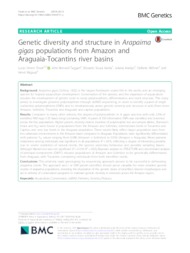Genetic diversity and structure in Arapaima gigas populations from Amazon and Araguaia-Tocantins river basins.
Genetic diversity and structure in Arapaima gigas populations from Amazon and Araguaia-Tocantins river basins.
Author(s): TORATI, L. S.; TAGGART, J. B.; VARELA, E. S.; ARARIPE, J.; WEHNER, S.; MIGAUD, H.
Summary: Background: Arapaima gigas (Schinz, 1822) is the largest freshwater scaled fish in the world, and an emerging species for tropical aquaculture development. Conservation of the species, and the expansion of aquaculture requires the development of genetic tools to study polymorphism, differentiation, and stock structure. This study aimed to investigate genomic polymorphism through ddRAD sequencing, in order to identify a panel of single nucleotide polymorphisms (SNPs) and to simultaneously assess genetic diversity and structure in wild (from rivers Amazon, Solimões, Tocantins and Araguaia) and captive populations. Results: Compared to many other teleosts, the degree of polymorphism in A. gigas was low with only 2.3% of identified RAD-tags (135 bases long) containing SNPs. A panel of 393 informative SNPs was identified and screened across the five populations. Higher genetic diversity indices (number of polymorphic loci and private alleles, Shannon?s Index and HO) were found in populations from the Amazon and Solimões, intermediate levels in Tocantins and Captive, and very low levels in the Araguaia population. These results likely reflect larger population sizes from less urbanized environments in the Amazon basin compared to Araguaia. Populations were significantly differentiated with pairwise FST values ranging from 0.086 (Amazon × Solimões) to 0.556 (Amazon × Araguaia). Mean pairwise relatedness among individuals was significant in all populations (P < 0.01), reflecting a degree of inbreeding possibly due to severe depletion of natural stocks, the species sedentary behaviour and possible sampling biases. Although Mantel test was not significant (P = 0.104; R2 = 0.65), Bayesian analysis in STRUCTURE and discriminant analysis of principal components (DAPC) showed populations of Amazon and Solimões to be genetically differentiated from Araguaia, with Tocantins comprising individuals from both identified stocks. Conclusions: This relatively rapid genotyping by sequencing approach proved to be successful in delineating arapaima stocks. The approach and / or SNP panels identified should prove valuable for more detailed genetic studies of arapaima populations, including the elucidation of the genetic status of described discrete morphotypes and aid in delivery of conservation programs to maintain genetic diversity in reservoirs across the Amazon region.
Publication year: 2019
Types of publication: Journal article
Observation
Some of Embrapa's publications are published as ePub files. To read them, use or download one of the following free software options to your computer or mobile device. Android: Google Play Books; IOS: iBooks; Windows and Linux: Calibre.
Access other publications
Access the Agricultural Research Database (BDPA) to consult Embrapa's full library collection and records.
Visit Embrapa Bookstore to purchase books and other publications sold by Embrapa.

